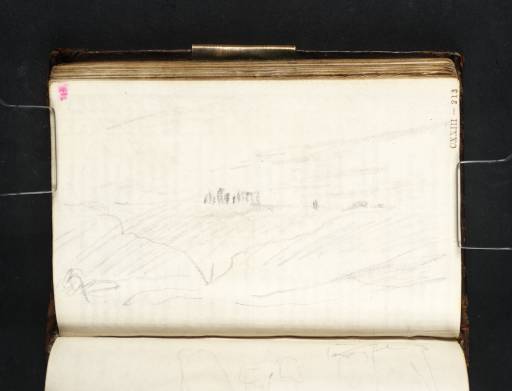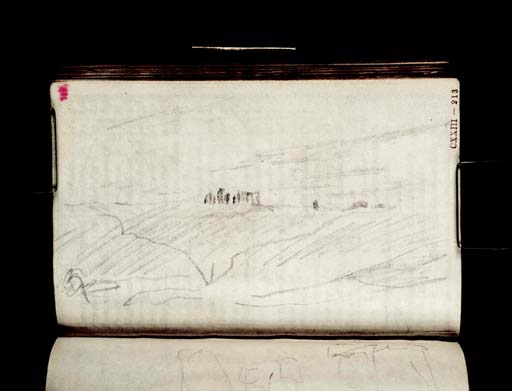Joseph Mallord William Turner Stonehenge from the Amesbury Road 1811
Image 1 of 2
Joseph Mallord William Turner,
Stonehenge from the Amesbury Road
1811
Joseph Mallord William Turner 1775–1851
Folio 216 Recto:
Stonehenge from the Amesbury Road 1811
D08752
Turner Bequest CXXIII 213
Turner Bequest CXXIII 213
Pencil on white wove writing paper, 75 x 117 mm
Inscribed by John Ruskin in red ink ‘213’ top left, ascending vertically
Stamped in black ‘CXXIII – 213’ top right, ascending vertically
Inscribed by John Ruskin in red ink ‘213’ top left, ascending vertically
Stamped in black ‘CXXIII – 213’ top right, ascending vertically
Accepted by the nation as part of the Turner Bequest 1856
References
1909
A.J. Finberg, A Complete Inventory of the Drawings of the Turner Bequest, London 1909, vol.I, p.352, CXXIII 213, as ‘Stonehenge’.
1988
115th Annual Exhibition of Watercolours and Drawings, exhibition catalogue, Thos Agnew & Sons, London 1988, p.[18] under no.74.
The view is from the east, where the Warminster and Wincanton roads fork north and south of Stonehenge, indicated by the wavy diagonal lines rising right and left respectively from the vertical stroke below the monument, which shows the position of a signpost at the junction. The Heel Stone is on the horizon to the right of the main circle.
Turner’s sketch is the basis of a watercolour which has been dated to circa 1811–12 or 13 (private collection), showing the stones silhouetted against a sunset with dark clouds streaking the bright sky;1 the alignment of crossroads, stones and sun indicates a summer sunset just within the north-west quadrant. Thin clouds are noted in the present sketch, and Turner may have witnessed the scene towards or at dusk towards the end of his summer West Country tour; the sun appears to be almost setting in two more detailed drawings made on the same occasion in the Stonehenge sketchbook (Tate D41383, D41385; Turner Bequest CXXV b 10, 12). It has been suggested that the watercolour was made on a sheet of the same paper.2
There are three further sketches of the site in the current book, on folios 214 verso and 215 recto and verso (D08749–D08751; CXXIII 211a, 212, 212a); in the first of these a low sun also appears to be indicated. For further drawings and related works see the introduction to the Stonehenge sketchbook.
By coincidence, the view is the same as that recorded by John Constable in July 1820, in one of two drawings made at Stonehenge (private collection).3 David Lucas’s mezzotint print, published after Constable’s death, appears to have been taken from a lost watercolour or painting (see the entry for Tate’s impression, T04100); it shows a rather Turnerian juxtaposition of setting sun and crescent moon.
Matthew Imms
June 2011
Not in Andrew Wilton, J.M.W. Turner: His Life and Work, Fribourg 1979; for details and dating see Thos Agnew & Sons, exhibition catalogue, 1988, p.[18]; see also C[harles] Lewis Hind, Turner’s Golden Visions, London and Edinburgh 1910, pl.VIII (colour) and Ian Warrell (ed.), Franklin Kelly and others, J.M.W. Turner, exhibition catalogue, National Gallery of Art, Washington 2007, p.82 no.47, reproduced (colour).
How to cite
Matthew Imms, ‘Stonehenge from the Amesbury Road 1811 by Joseph Mallord William Turner’, catalogue entry, June 2011, in David Blayney Brown (ed.), J.M.W. Turner: Sketchbooks, Drawings and Watercolours, Tate Research Publication, December 2012, https://www


